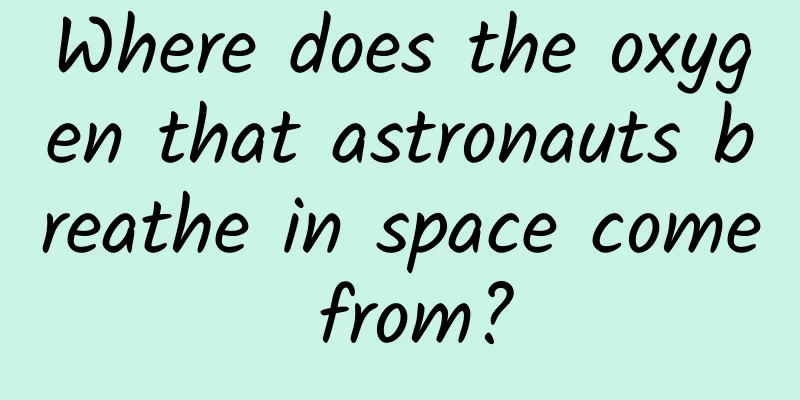Where does the oxygen that astronauts breathe in space come from?

|
In early April 2021, I joined an expedition to confirm the site selection for a station to house instruments and equipment to detect space phenomena and monitor the state and changes of the universe around the Earth under the influence of solar activity. Some of these devices are very sensitive to human activities, so they often need to be placed in remote areas with vast land and sparse population. One of the candidate sites is the Nagqu area in Tibet. Nagqu is located in northern Tibet, in the heart of the Qinghai-Tibet Plateau. It is the source of the Yangtze River, Nujiang River, Lhasa River, Yigong Zangbo River and other major rivers. The eastern part of Nagqu City is a plateau mountainous area with an altitude of 3,800-4,500 meters and an average altitude of about 4,100 meters. The site this time has an altitude of about 4,800 meters. The expedition team measured it shortly after getting off the train and found that it was about 4,400 meters. When the expedition team got off the train in Nagqu, the altitude was over 4,400 meters (Source: Self-made) As a native of the Central Plains, I had headaches and other symptoms early on. Many people in the expedition team needed oxygen. Fortunately, the hotel had oxygen dispensers and you could buy oxygen at the pharmacy. An inflatable pillow that can be used to breathe oxygen for 40 minutes costs 50 yuan, and it only costs 5 yuan to inflate it. So we joked that it was not the oxygen that was expensive, but the "qualification" to breathe oxygen. Part 1 What is "altitude sickness"? Altitude sickness, also known as altitude sickness or mountain sickness, is strictly speaking a type of altitude sickness. Rapidly entering a plateau above 3,000 meters from a low altitude area and being exposed to a low-pressure, low-oxygen environment will cause various discomforts. This is altitude sickness, a common disease unique to plateau areas. Common symptoms include headache, insomnia, loss of appetite, fatigue, and difficulty breathing. Headache is the most common symptom, often with throbbing pain in the forehead and bilateral temporal region, which is aggravated at night or when getting up in the morning. Taking my experience this time as an example, I felt a dull headache at night, couldn't sleep well, and felt particularly tired in the morning. The air pressure on the plateau is usually half of that on the plains, and the oxygen content is relatively thin. The lack of oxygen causes what we often call altitude sickness. For people with weaker bodies, the underlying diseases will worsen, and even the above-mentioned dizziness, headache, dyspnea, palpitations, fatigue, and weakness will occur. Usually, after 3-5 days of oxygen inhalation to a certain extent, the symptoms of mild cases can gradually disappear and be relieved; but if the altitude sickness is severe, obvious high-altitude pulmonary edema and cerebral edema will occur, which is very dangerous. Altitude sickness "those things" (Image source: https://inews.gtimg.com/newsapp_bt/0/11853206941/641) Part 2 Why is there less oxygen as you go higher on Earth? Although the air around us cannot be seen or touched, it is actually attracted by the earth's gravity and has weight. It is just because we are used to the air pressure on the earth's surface, the human body can achieve internal and external pressure balance, so we don't feel that we are "squashed". Since the air is concentrated around the earth by the earth's gravity, the closer to the earth, the stronger the gravity, the more gas is gathered, and the greater the pressure of the gas. When it is far from the earth, the gravity is weaker, the gas is not so dense, and the pressure is lower. In other words, air pressure is the gravity exerted on the vertical air column extending from where we stand to the upper boundary of the atmosphere. If I climb to the Nagqu station at an altitude of 4,800 meters, the air column above my head starts from 4,800 meters and goes up to thousands of kilometers. Without the bottom 4,800 meters, the pressure exerted by the air column on the bottom is far less than the pressure exerted by the complete air column on the plain; accordingly, the compressed air density is also smaller in places with lower pressure, and the air density at 4,800 meters is also lower than that on the plain. Therefore, the higher you go, the lower the air pressure and density, until it becomes a "vacuum". The lower the air density, the less oxygen there is in the air. And because oxygen is heavier, the oxygen actually decreases faster at higher altitudes, and then only hydrogen remains in the air, or even to the point where there is no air at all. However, it is the oxygen in the air that we humans rely on to survive. The air pressure and oxygen content are low at high altitudes (Image source: https://www.meipian.cn/2cbosflq) Part 3 What are the ways to obtain oxygen to breathe in space? The higher you go, the thinner the air is. So, isn't there no air in "space"? In October 2021, the Shenzhou 13 manned spacecraft carrying the "space business trip trio" successfully entered space. According to the mission, the three astronauts will stay in space for 6 months, and they will celebrate the Spring Festival in space. For such a long time, where does the oxygen they breathe come from? The outer space is not as low as 4,800 meters. The lowest altitude of the outer space around the earth is about 100,000 meters. There is almost no air here, and the air pressure is even one millionth of that on the ground. If astronauts want to breathe here, it’s not as simple as “replenishing oxygen”. The first method is of course to bring oxygen tanks directly from the ground, just like our expedition team bought oxygen bags and oxygen cylinders in Tibet. This method is the most direct, but also very inefficient. Portable oxygen cylinders commonly seen in mountaineering (Image source: Rehabmart.com) The second method is a solid fuel oxygen generator. This method mainly produces oxygen through chemical reactions. Similar equipment can also be purchased in Tibet. Solid raw materials are easy to store and can store more oxygen in a smaller volume. For example, when a metal can containing a mixture of powdered sodium chlorate and iron powder is ignited, the iron burns and produces the heat energy required for the chemical reaction, and the corresponding chemical reaction produces sodium chloride and oxygen. Commercial aircraft also use a similar method to produce oxygen when the cabin pressure drops. The third method is to electrolyze water. This method is rarely used on the ground, but it is a very important means of providing oxygen in the space station. On the ground, electrolysis of water consumes a lot of energy, and the hydrogen produced is dangerous. However, power supply is not a problem on the space station. The huge solar panels can supply free electricity, and the hydrogen produced can also be discharged into space. Water, as raw material, can be transported from the earth to the space station by supply ships, and water vapor in the cabin air can be recovered by condensers, and even astronauts' urine can be used for filtration and recovery. It is reported that the oxygen generator of the International Space Station is an oxygen-generating device that electrolyzes water. The interior of the International Space Station (Image source: Baidu Gallery) Part 4 To breathe in space, you can't just go in without going out When humans breathe, they consume oxygen and exhale carbon dioxide. The space station is sealed, so after a long time, wouldn't the room be filled with carbon dioxide? Where does the carbon dioxide go? This requires mentioning the air system in the space station, which not only prepares and provides oxygen, but also needs to process the carbon dioxide exhaled by astronauts. The carbon dioxide produced in the air that astronauts breathe has been processed by the air system, such as using zeolite molecular sieves to remove carbon dioxide in the air. In other words, the air system must not only be able to produce oxygen, but also be able to remove carbon dioxide. There are other gases in the air, such as methane, acetone, methanol and carbon monoxide, which can be removed with the help of activated carbon filters on the space station. Therefore, the breathing system used by astronauts should actually be called an air circulation and filtration system, not just oxygen preparation. It is with the help of these air systems that the astronauts can spend the New Year safely in space and successfully complete their missions. Let us look forward to their triumphant return! Produced by: Science Popularization China Produced by: Wang Zheng Producer: Computer Network Information Center, Chinese Academy of Sciences (The images with source indicated in this article have been authorized) The article only represents the author's views and does not represent the position of China Science Expo This article was first published in China Science Expo (kepubolan) Please indicate the source of the public account when reprinting China Science Expo |
<<: Refresh your cognition! Chinese researchers create the first "never-melting ice and snow"
Recommend
Why is Tik Tok rebelling against Tencent?
Toutiao and Tencent have recently started a fight...
Activity analysis: 10 yuan storm activity analysis and tips sharing
China Merchants Bank’s Palm Storm was first launc...
"Space Express" is about to be delivered! The cargo list of Tianzhou 6 has been updated →
According to the plan, after the May Day holiday,...
Wuhan Tea Contact Information
Wuhan high-end tea drinking is unique and very un...
Why do I always wake up when I reach my stop after falling asleep on the subway?
Audit expert: Sun Tao National Psychological Coun...
Avatar caching strategy recommended by experts
[[151245]] Many apps have user systems, whether t...
Life blooms, flames dance...space experiments are so interesting!
Produced by: Science Popularization China Author:...
If I cut my finger, can I disinfect it by sucking on it in my mouth?
"Ouch, your finger is injured, put it in you...
Tu Ma "Hot Copywriting" Hard-core Special Forces Incubation Camp
The course comes from the popular copywriting har...
How can humans achieve "banana freedom"? First, cure the "cancer" of bananas!
1. Overview 1.1 Banana’s function and value Banan...
Online production of Ukrainian beauties holding signs and shouting videos, online orders, sincerely recruiting agents!
The beauty sign-holding team includes the Russian...
Nokia launches Android tablet: Escape and comeback
Only half a year after selling its device and ser...
12306 applies for a patent to prevent automatic ticket grabbing. Is the ticket grabbing software still useful?
Today is the first day of the Spring Festival tra...
Don't buy this kind of bird! Someone has been caught
The mynah bird, which can imitate a variety of me...
If you suddenly stand up and feel dizzy, don't take it lightly, it may be a sign of illness.
If you stand up suddenly after squatting, you may...









